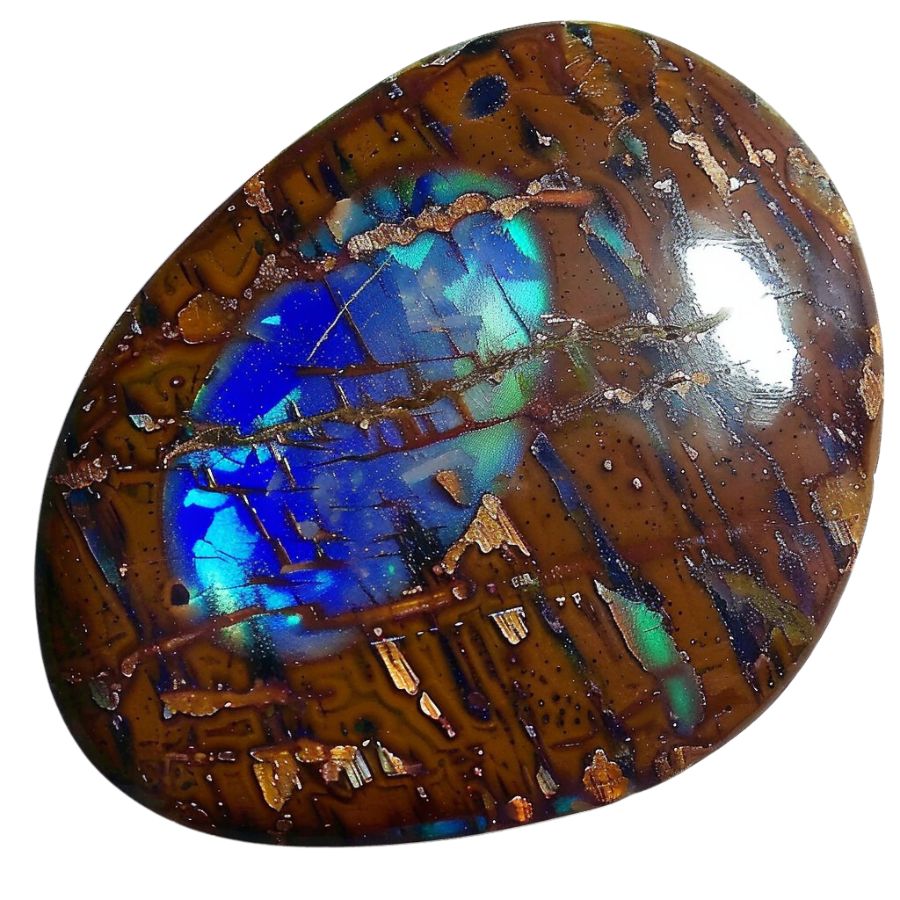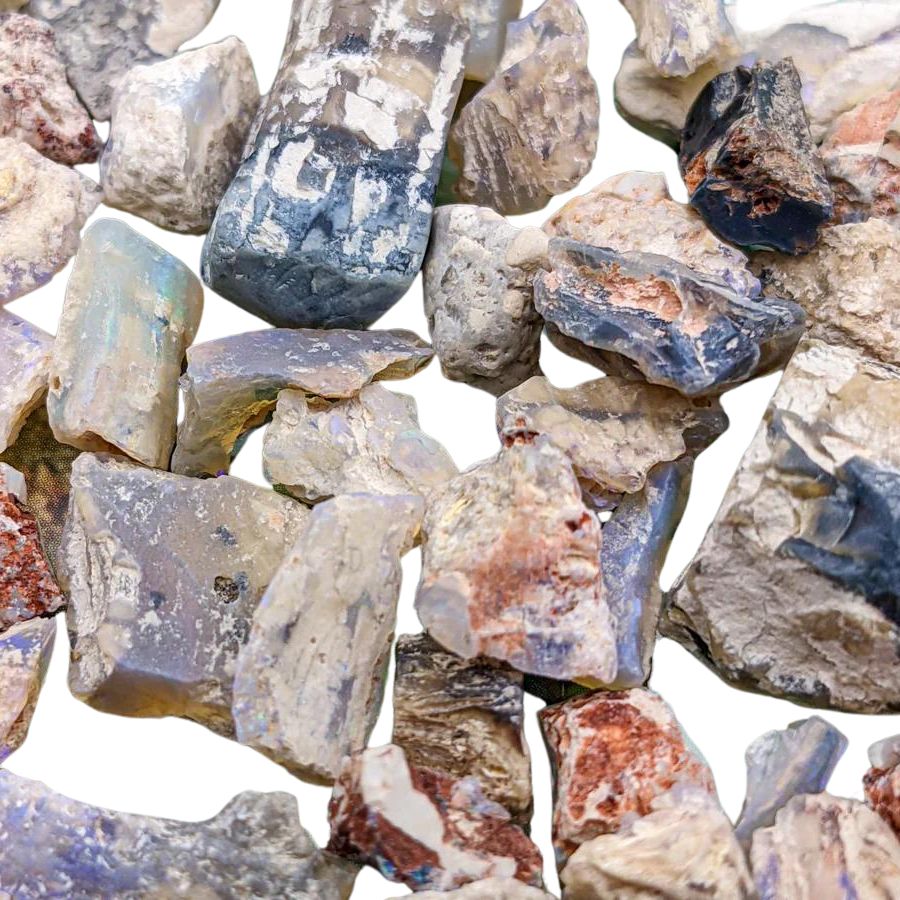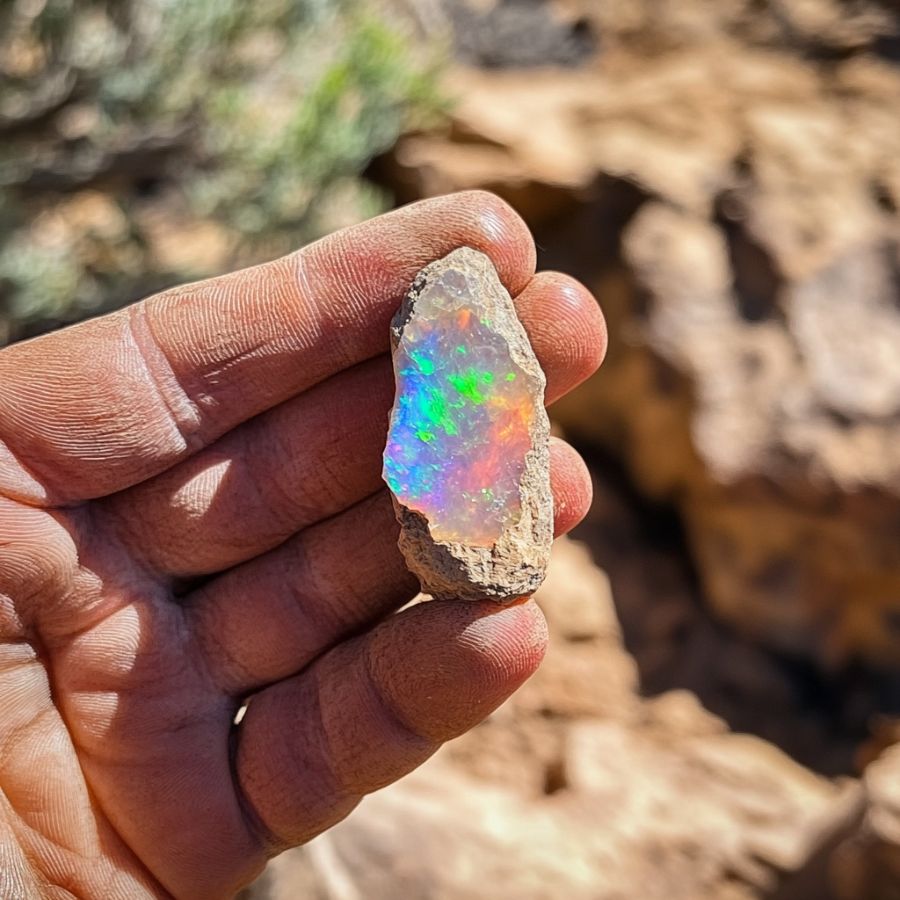Kentucky’s rich mineral heritage goes beyond coal and limestone. While many folks associate opals with Australia, our state has its own hidden treasures waiting to be discovered.
Whether you’re a first-time rockhound or a seasoned collector, finding the right spot to search for opals can be tricky. We’ve spent months talking to local collectors and geologists to find the most promising locations across the state.
Here, we’ll share the best spots where you can try your luck at finding opals. We’ve done the hard work of checking which places are accessible and actually worth your time, so you don’t have to drive around aimlessly or waste your weekend at spots that won’t pan out.
How Opal Forms Here
Opal forms here through a fascinating natural process. When water containing silica seeps into cracks and voids in rocks, it begins to evaporate, leaving behind tiny silica spheres.
Over time, these spheres stack in a grid-like pattern, creating opal. This process can take millions of years!
The colors in opal come from the way light refracts through the silica spheres. Different conditions in the ground, like the type of rock and the presence of other minerals, can affect the opal’s type, color, and quality.
The Types Of Opal
There are several incredible types of Opal that can be found in the US as well as in our state. Each is uniquely beautiful and interesting including:

Common Opal
Common opal, also known as “potch,” stands out from other types of opal due to its lack of play-of-color, the iridescent display seen in precious opal. Instead, common opal features consistent, solid colors like white, pink, yellow, green, and blue.
It typically has a waxy to pearly luster and ranges from opaque to translucent. To identify common opal, look for its uniform color and absence of the shimmering color flashes found in precious opal.
Common opal forms under similar geological conditions as other opals, where silica-rich water seeps into rock cavities and slowly hardens over time. This process usually occurs in areas with volcanic activity or hot springs, where silica deposits are prevalent.

Fire Opal
Fire opal is known for its warm, vibrant colors, ranging from yellow and orange to deep red. Unlike precious opal, fire opal may or may not display the play-of-color, but its fiery body color makes it unique.
To identify fire opal, look for its bright, translucent to transparent appearance and the absence or presence of play-of-color within the warm hues.
Fire opal forms in volcanic regions where water rich in silica interacts with hot lava, filling cavities and fractures within the rock. Over time, the silica solution hardens, creating opal.
Visually, fire opal’s appeal lies in its vivid, flame-like colors that can be either uniform or exhibit internal flashes of color.

Boulder Opal
Boulder opal forms within the ironstone boulders of its host rock. Unlike other opals, boulder opal features precious opal veins intertwined with the natural rock, creating a beautiful contrast.
This opal is distinguished by its combination of colorful opal patches and the surrounding matrix, which can include ironstone or sandstone. To identify boulder opal, look for its vibrant play-of-color within the darker host rock, often showcasing brilliant blues, greens, and reds.
Boulder opal forms in sedimentary environments where silica-rich water infiltrates cracks and voids within ironstone or sandstone boulders. Over time, the silica hardens into opal, often creating thin seams or patches within the rock.

Hyalite Opal
Hyalite opal, also known as water opal, is a transparent to translucent type of opal that is distinctive for its glass-like appearance and lack of play-of-color. Unlike precious opal, which displays a rainbow-like iridescence.
You can identify hyalite opal by its clear to milky appearance, often with a slight green or blue fluorescence under UV light.
Hyalite opal forms in low-temperature hydrothermal environments, typically in volcanic regions. It precipitates from silica-rich fluids that fill cracks and voids in the host rock. This process can occur relatively quickly compared to other opal types.
Visually, hyalite opal resembles droplets of water or glass, often appearing as smooth, botryoidal (grape-like) formations. Its transparent nature makes it unique among opals, and its slight fluorescence adds to its allure.

Black Opal
Black opal is a rare and highly prized variety known for its dark body tone, which enhances the vibrant play-of-color. Unlike other opals, black opal has a deep background color, ranging from dark gray to jet black, making the iridescent colors more striking.
To identify black opal, look for its intense, dark base color coupled with brilliant flashes of blues, greens, reds, and other hues.
The presence of iron and carbon contributes to its dark body color. In the United States, black opal is primarily found in the Virgin Valley of Nevada, known for its rich opal deposits.

Crystal Opal
Crystal opal is known for its transparent to translucent body, which allows the play-of-color to shine through brilliantly. Unlike common opal, which is opaque, crystal opal’s clear or semi-clear nature enhances its vibrant internal colors.
To identify crystal opal, look for its see-through quality combined with flashes of color that can include blues, greens, reds, and more.
Its unique transparency sets crystal opal apart, making it a favorite among gem enthusiasts and collectors for its ethereal beauty.

Wood Opal (Opalized Wood)
Opalized wood is a fascinating form of petrified wood where the organic material has been replaced by opal. Unlike other opals, opalized wood retains the original structure and texture of the wood, creating a unique blend of organic and mineral elements.
To identify opalized wood, look for its wood grain patterns and opalescent sheen, often displaying a range of colors from white and brown to vibrant reds and greens.
Opalized wood forms under specific conditions where wood is buried in silica-rich sediment. Over millions of years, the silica solution gradually replaces the organic wood material with opal, preserving the wood’s original structure in stunning detail.

Contra Luz Opal
Contra Luz opal reveals its vibrant play-of-color when illuminated from behind. Unlike other opals, which display their colors through surface reflection, contra luz opal’s brilliance comes to life with transmitted light.
To identify contra luz opal, hold the gem against a light source and observe the internal flashes of color, which can include vivid reds, blues, greens, and purples.
This opal forms in volcanic environments where silica-rich water infiltrates cracks and cavities in the host rock. As the water evaporates, it leaves behind silica deposits that eventually solidify into opal.
Visually, contra luz opal appears nearly clear or milky when viewed without backlighting. However, when backlit, it displays stunning, colorful patterns that seem to glow from within.
What Rough Opal Looks Like
When you’re out looking for rough opal on your own it’s important to know what you’re looking for. This is what you need to look out for:
If you want REAL results finding incredible rocks and minerals you need one of these 👇👇👇
Finding the coolest rocks in isn’t luck, it's knowing what to look for. Thousands of your fellow rock hunters are already carrying Rock Chasing field guides. Maybe it's time you joined the community.
Lightweight, mud-proof, and packed with clear photos, it’s become the go-to tool for anyone interested discovering what’s hidden under our red dirt and what they've already found.
Join them, and make your next rockhounding trip actually pay off.
What makes it different:
- 📍 Find and identify 140 incredible crystals, rocks, gemstones, minerals, and geodes across the USA
- 🚙 Field-tested across America's rivers, ranchlands, mountains, and roadcuts
- 📘 Heavy duty laminated pages resist dust, sweat, and water
- 🧠 Zero fluff — just clear visuals and straight-to-the-point info
- ⭐ Rated 4.8★ by real collectors who actually use it in the field
Look for exteriors like this

Look for play-of-color

Opal can display a range of colors, but what sets precious opal apart is its play-of-color—vivid flashes of multiple colors that change with the angle of light. Even in rough form, you might see hints of these colors peeking through.
Common opal lacks this feature and typically appears as a solid color like white, blue, or pink.
Check for a glassy or waxy luster

Opal often has a distinctive glassy or waxy luster. When you find a potential opal, examine its surface.
It should look shiny and smooth, almost like glass, even if it is still encased in a matrix or rough exterior.
Assess the density and weight

Opal is generally lighter than rocks of a similar size. When you pick up a piece of rough opal, it should feel lighter than expected.
Additionally, opal is relatively soft, with a Mohs hardness of 5.5 to 6.5, so it can be scratched more easily than quartz or other harder minerals.
A Quick Request About Collecting
Always Confirm Access and Collection Rules!
Before heading out to any of the locations on our list you need to confirm access requirements and collection rules for both public and private locations directly with the location. We haven’t personally verified every location and the access requirements and collection rules often change without notice.
Many of the locations we mention will not allow collecting but are still great places for those who love to find beautiful rocks and minerals in the wild without keeping them. We also can’t guarantee you will find anything in these locations since they are constantly changing.
Always get updated information directly from the source ahead of time to ensure responsible rockhounding. If you want even more current options it’s always a good idea to contact local rock and mineral clubs and groups
Tips on where to look
Once you get to the places we have listed below there are some things you should keep in mind when you’re searching:
Search in Sedimentary Rock Formations

Opal can also form in sedimentary rock formations where silica deposits have accumulated over time.
Focus on areas with ancient lake beds or clay deposits, as these environments are conducive to opal formation.
Check Dry Creek Beds and Gullies

Dry creek beds and gullies can be excellent places to find opal, as water flow can erode and expose opal-bearing rocks.
Look for exposed rock and gravel in these areas, especially after rainfall or seasonal flooding.
Investigate Old Mining Sites

Abandoned or historical mining sites can be rich in opal and other minerals. These areas often have tailings and discarded rock that may still contain opal.
Always seek permission if the land is privately owned and follow safety guidelines.
Look for Indicator Minerals

Certain minerals can indicate the presence of opal. Look for rocks and soil containing ironstone, sandstone, or clay, as these materials often coexist with opal deposits.
Additionally, finding quartz or chalcedony can suggest nearby opal.
Some Great Places To Start
Here are some of the better places to start looking for Opal in Kentucky:
Always Confirm Access and Collection Rules!
Before heading out to any of the locations on our list you need to confirm access requirements and collection rules for both public and private locations directly with the location. We haven’t personally verified every location and the access requirements and collection rules often change without notice.
Many of the locations we mention will not allow collecting but are still great places for those who love to find beautiful rocks and minerals in the wild without keeping them. We also can’t guarantee you will find anything in these locations since they are constantly changing.
Always get updated information directly from the source ahead of time to ensure responsible rockhounding. If you want even more current options it’s always a good idea to contact local rock and mineral clubs and groups
Red River Gorge Area

The Red River Gorge Area sits in east-central Kentucky, inside the Daniel Boone National Forest. This massive canyon system follows the Red River and is famous for its tall sandstone cliffs and natural bridges.
The place is part of the Pottsville Escarpment, which gives it special rock layers perfect for forming minerals. Opals have been found in the sandstone cliffs and rock shelters throughout the gorge.
The best spots to look for opals are near Natural Bridge State Park and in the Clifty Wilderness Area. These places have lots of exposed rock walls where minerals often form. The area also has other stones like quartz and jasper.
The gorge’s many hiking trails make it easy to reach good rockhounding spots. Rock climbers have often spotted interesting minerals while scaling the cliffs, so checking around popular climbing areas can be useful too.
Green River

The Green River flows through Edmonson County in western Kentucky, running along the edges of Mammoth Cave National Park. This river is a key part of Kentucky’s largest karst region, home to the world’s longest cave system.
The river cuts through ancient limestone beds that formed millions of years ago when this area was under a shallow sea. The water has carved out countless caves and underground passages in the area.
Opals are found in the weathered limestone outcrops near the river banks. The best spots to look are where the limestone meets the water’s edge.
Rock collectors often find success searching the gravel bars and stream beds where the river has exposed fresh rock material. The Green River area also yields other interesting finds like fluorite and Kentucky agate.
Cumberland Falls

Cumberland Falls stands as a massive 68-foot waterfall in southeastern Kentucky, about 20 miles from Corbin. The waterfall flows over a large rock ledge on the Cumberland River and creates a stunning 125-foot wide curtain of water.
The falls area sits on ancient sandstone layers called the Rockcastle Conglomerate. These rocks formed millions of years ago from sand and pebbles that were pushed together.
Opals are often found in the cracks and spaces between these rock layers. The best spots to look for opals are along the riverbanks downstream from the falls.
Search in areas where the water has worn away the rocks, especially after heavy rains when new material gets exposed. The Eagle Falls Trail area is particularly good for finding interesting rocks and minerals.
Ohio River

The Ohio River flows along Kentucky’s northern border, creating a natural boundary with Illinois, Indiana, and Ohio. This mighty river has shaped the landscape for millions of years, leaving behind rich deposits perfect for gemstone hunting.
The river’s deep channel and banks contain layers of alluvial deposits from the Ice Age. These deposits are full of various minerals and stones, including opals.
The river valley’s unique geology comes from glacial activity during the Pleistocene epoch. As glaciers melted, they left behind sand, gravel, and mineral deposits.
Good hunting spots for opal and other minerals include areas where streams meet the main river and spots with visible gravel deposits. Spring and fall are ideal times to search, as water levels are usually lower, exposing more riverbank areas.
Places Opal has been found by county
After discussing our top picks, we wanted to discuss the other places on our list. Below is a list of the additional locations where we have succeeded, along with a breakdown of each place by county.
| County | Location |
| Carter | Carter Caves State Resort Park |
| Lyon | Lake Barkley |
| Edmonson | Mammoth Cave National Park |
| Mercer | Harrodsburg Area Creeks |
| Fayette | Lexington Quarry |
| Boone | Big Bone Lick State Historic Site |
| Crittenden | Crittenden County Old Minesites |
| Powell | Powell County Creeks |
| Jackson | Jackson County Creeks |
| Rockcastle | Rockcastle County Riverbeds |
| Graves | Graves County Sandpits |
| Caldwell | Princeton Area Quarries |
| Estill | Estill County Creeks |
| Ballard | Wickliffe Mounds State Historic Site |
| Crittenden | Columbia Mine Area |
| McCracken | Big Four Fault Area near Sheridan |
| Woodford | Old Mine Dumps near Mundys Landing |



